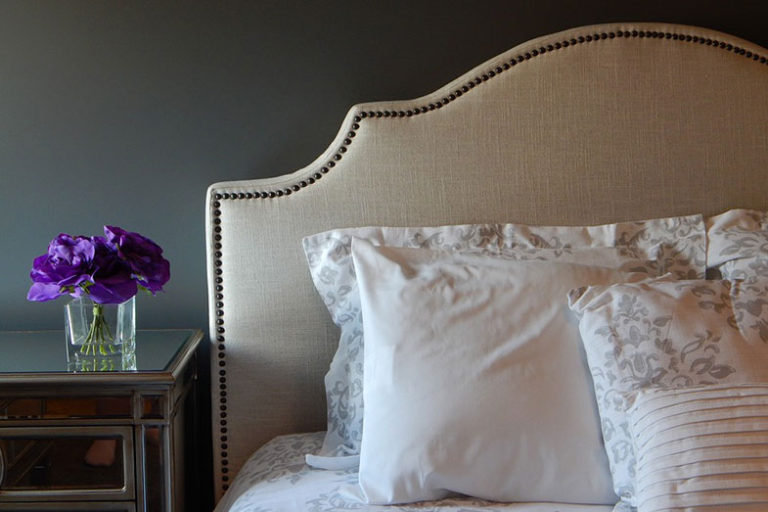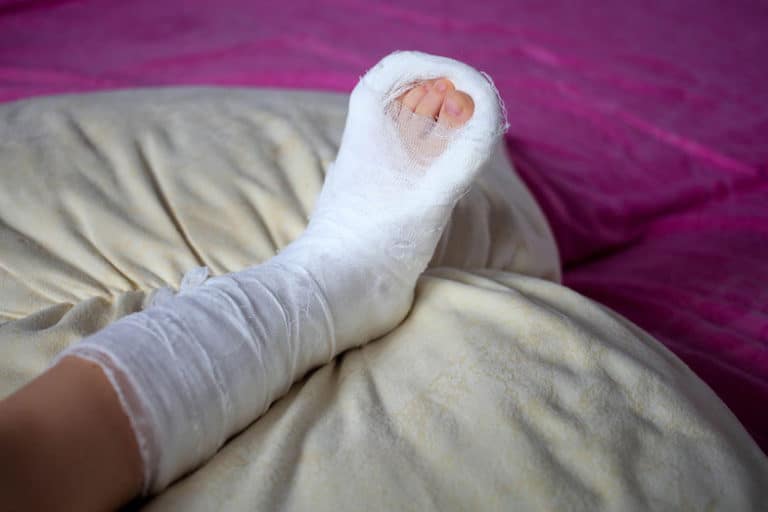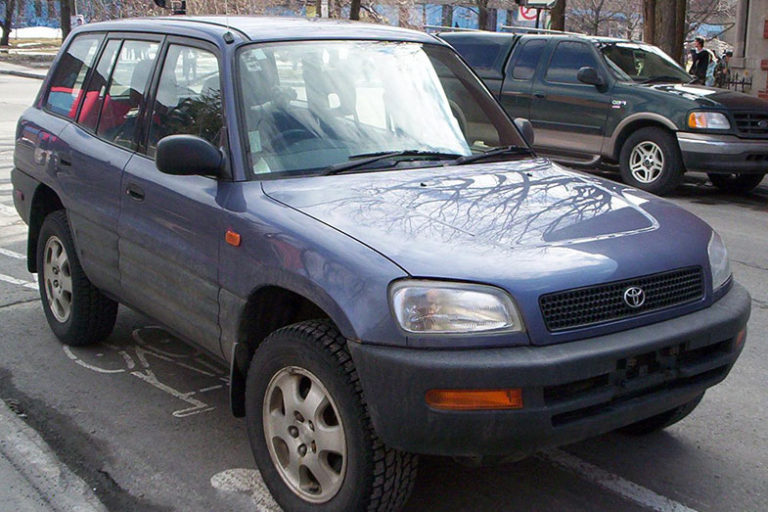How to Sleep with a Broken Bone
Disclosure: We may get commissions for purchases made through links in this post.
If you have a broken bone, you’re probably finding it difficult to sleep at night. While rest is one of the quickest ways to recovery, comfortably positioning yourself can be a challenge. What makes it even more difficult is when you are bound by a sling, cast, or splint. So you may be wondering, how do I sleep with a broken bone?
Find a comfortable position that will allow you to sleep throughout the night. Use pillows to elevate the injury and prevent swelling. Take pain medication as advised by your doctor, and dress comfortably.
Depending on the injury and type of sleeper you are, positions will differ. In this article, we are going to look at some of the most common broken bones and how to sleep with them.
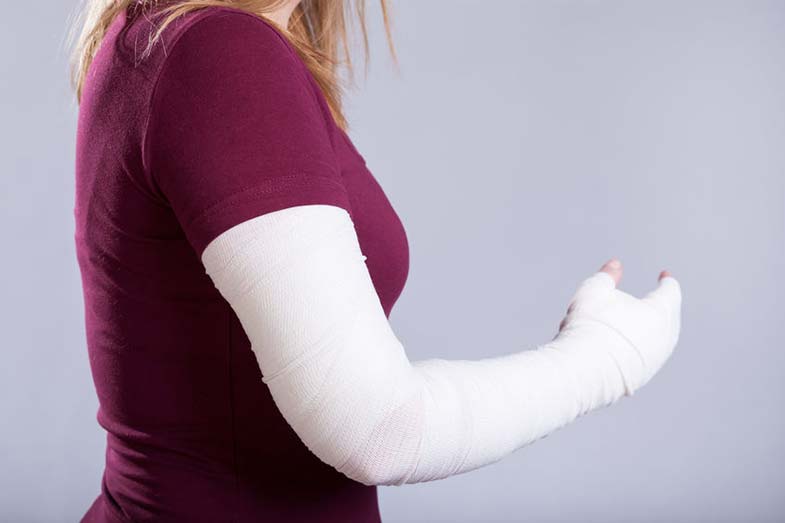
How to Sleep with a Broken Bone
Jump to a section:
1. Broken Arm
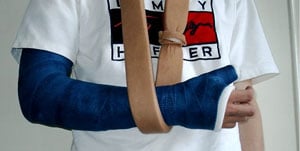
Studies show that half of all broken bones in adults usually occur in the arm. Having a broken arm can affect your day-to-day activities, including sleeping. Of course, sleep is essential and highly recommended for speeding up the recovery process. However, as you lay to get some sleep, your arm is likely to rest below your heart, resulting in increased pain and swelling.
How to Sleep with a Broken Arm
Here are some tips to make the best of your bedtime with a broken arm:
- Sleep with an arm sling
Sleeping with an arm sling is often recommended, especially during the first six weeks to restrict the movement of the broken arm. If you are wearing a sling to bed, you might find it comfortable to lie on your back with one pillow under your head, or even none. Place an arm elevation pillow below the injured arm for extra support. The pillow will help elevate the broken arm above the body as swelling eases. - Lie on the side with your arm resting palm down
If you are using a full-length body pillow or love to sleep on your stomach, then your arm should be resting palm down on the pillow. This position also works well for those who experience pain on the outside of the forearm.
2. Broken Leg
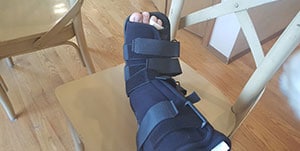
Sleeping with a broken leg can be frustrating, particularly for the first few weeks. Healing usually takes 6-8 weeks, and rest is highly recommended to speed up the recovery process.
How to Sleep with a Broken Leg
If you are wondering how to get some rest with a broken leg, here are some steps to follow:
- Pick the right sleeping position
The best sleeping position is to lie on your back to protect your leg from swelling and pain. Alternatively, you can sleep on your side once the swelling has gone down. If you sleep on your side, avoid elevating your broken leg as much as possible, and keep both legs separate. You can even ask your family members to sleep in a different room until you find a position that you are most comfortable with. - Elevate your leg
Elevating your broken leg above your heart is necessary as it prevents swelling. You may want to invest in specialized pillows like a body pillow, which keeps your leg above your heart. You could also rest your leg on a stack of pillows. - Position your pillows
You need to know how to position your pillows to ensure proper support and elevation for your leg. We recommend using three pillows. One should be placed horizontally at the foot of your bed. Another one should be on top of the first one in a vertical position and parallel to your leg. Lastly, the third pillow should be placed vertically nearer to you and resting under your hamstring. You must try different positions until you find the one most comfortable for you. - Make sure your body is stabilized
Once you find an appropriate sleeping position, you need to make sure that your body is stabilized throughout the night. Tossing and turning can create interruptions, which can only aggravate the injury. A barrier of pillows or blankets can help keep your body in a stable position.
3. Broken Ankle

If you have broken your ankle and are bound by a cast, comfort and sleep can be elusive. The ankle is made up of the bottom ends of fibula and tibia, tendons, ligaments, and the connecting foot bones. If the ankle twists, the tibia, and fibula could have fractures within or near the ankle joint. This problem usually occurs during sports, like soccer, rugby, or basketball.
How to Sleep with a Broken Ankle
To achieve sound sleep with a broken ankle, simply follow these steps:
- Elevate your foot
Use specialized pillows, folded blankets, or an adjustable base to keep the broken bone elevated to reduce swelling. Elevating your injury can significantly help with the pain and allow you to get a good night’s sleep. - Position your foot
If you opt to sleep on your back, make sure that you use pillows to position your foot higher than your heart. If you sleep on your side, place pillows between your legs, beginning from above the knee to the cast. Both legs should be parallel with the other leg above the injured leg. This helps with spine alignment. - Position yourself on the bed
The last thing you want is to fall from the bed and exacerbate the broken ankle. For this, position yourself in the middle of the bed and tuck in the blanket. Also, if the mattress is not comfortable enough, try resting on a couch. Stretch out the injured leg on the couch’s backside and use the armrest to raise your leg. - Dress comfortably
Always pick the right clothing to wear to bed, as being too hot or cold could affect your circulation and slow down the healing process. Choose a comfortable, breathable, and light clothing that will make you stay cool and not itch under the cast. If the temperatures are cold, wear a long-sleeve shirt and sweatpants.
4. Broken Wrist
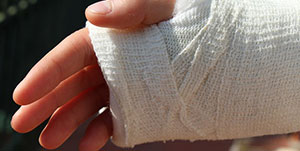
A broken wrist is the most common type of arm fracture that usually happens when a person lands on their entire weight. When one falls on an outstretched hand, bones in the wrist can buckle, leading to a Colles fracture. Research shows that wrist fractures are common in people below the age of 75 years.
How to Sleep with a Broken Wrist
- Lie on your back
When you have a broken wrist, the best position is to lie on your back and place pillows below your knees. You can choose to use one or no pillow beneath your head. If lying on your back doesn’t work, adjust yourself slowly to a side position. Also, if the bed is uncomfortable, try sleeping on the couch. - Elevate hand
When sleeping with a broken wrist, try to keep your hand elevated so that the elbow is just above or at the level of the heart while the hand and wrist are higher than the elbow. First, lie on your back or opposite side of the wrist that is not injured. Take a pillow and place it across your chest and let the cast of the injured arm rest on the pillow. Another option is to position a few pillows on whichever side of your elbow and ensure that your fingers are pointing to the ceiling. - Dress light
Wearing a sling or a heavy cast can cause body heat, which can be uncomfortable. Therefore, dress in loose-fitting and light layers of cool sleepwear.
5. Broken Hip

Is your painful hip making it difficult to sleep? Well, the answer may lie in your sleeping position. When you find the right sleeping position, your bedtime routine will be significantly improved.
How to Sleep with a Broken Hip
- Find the right position
It is best to lie on the side for hip and groin injuries while ensuring that the injured side faces the ceiling. Use pillows between your legs to maintain alignment for your hips, pelvis, and spine. If sleeping on your side aggravates the pain, you can switch things up by sleeping on your back. This will help distribute your weight evenly as well as reduce pressure points. When sleeping on your back, use a pillow to support your neck. Also, place one between your knees to prevent crossing the injured hip across your middle body. - Use a pad under the joint
Use a pad or extra cushioning to protect your joint while sleeping. As you lie on your back, place a blanket or thin pillow beneath the bad hip to relieve pressure. - Use ice on the area
One of the causes of hip pain is the swelling of the bursa, a fluid-filled sac that is responsible for cushioning the joints. If this condition causes your hip pain, a quick remedy is to place a pack of ice on your hip before going to bed. Make sure you wrap the ice pack with a thin towel or paper towel since direct contact should be avoided.
6. Broken Collarbone

Try sleeping on your back with propped-up pillows to keep the fractured clavicle above your heart. You can choose to lie on your side if the pain is on one shoulder. Place one below your head and another one between your legs and let the injured shoulder face the ceiling. If your bed is not comfy enough, try sleeping on a sofa or reclining chair.
How to Sleep with a Broken Collarbone
- Sleep on your back
Try sleeping on your back with propped up pillows in order to keep the fractured clavicle above your heart. You can choose to lie on your side if the pain is experienced on one shoulder. Place one below your head and another one between your legs and let the injured shoulder face the ceiling. If your bed is not comfy enough, try sleeping on a sofa or reclining chair. - Use extra pillows
If you can’t sleep comfortably, use extra pillows to keep yourself in an upright position.
How Casts Heal Broken Bones and the Problems of Wearing One
Wearing a cast is one of the treatments for broken bones because they support the affected area and allow the body to heal itself properly. Once a doctor determines the extent of the damage, they will try various settings to help align the broken ends of the bone and apply the cast.
However, some problems can arise from wearing a cast, one of which is keeping it dry. If your cast is not waterproof, you need to come up with ways to keep the cast dry, like covering it with a plastic bag or sleeve. Take care not to get your plaster cast wet as it can dissolve and irritate the skin. Similarly, waterproof casts don’t offer complete protection and need to stay away from water.
Another problem is the inability to move your toes or fingers beyond the cast. It is, therefore, recommended that you wiggle your toes and fingers to help with circulation. When you develop wounds or unusual odors beneath the cast, notify your doctor. Be sure to care for your cast so you can speed up the recovery and return to your usual daily routine.

